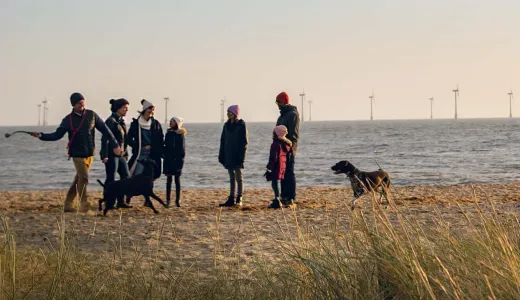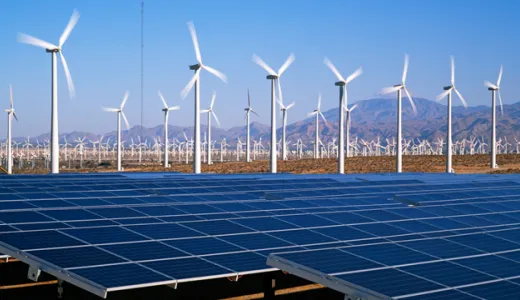What is nuclear energy (and why is it considered a clean energy)?
The power of the atom has been at the heart of electricity generation for more than half a century. Now nuclear fission – the process by which nuclear energy is used to generate electricity – looks set to support the future of clean, net zero energy systems globally.
Nuclear energy has been part of the global energy mix since nuclear reactors first started producing power in the early 1950s. From its heyday in the 1960s to the late 1980s, nuclear power’s popularity has risen and fallen – and has often been a source of controversy.
Today it plays a role in helping to provide clean, low-carbon electricity and could be pivotal in our efforts to reach net zero by 2050.
How does nuclear energy work?
Nuclear power stations work in a very similar way to coal- and gas-fired power stations, but the science behind the nuclear production process is much more advanced.
In a nuclear reactor, a reaction is driven by the splitting of atoms – a process called nuclear fission – where a particle is fired at an atom to split it into two smaller atoms (and some additional neutrons). The neutrons released hit other atoms, causing them to divide and release more neutrons. This is called a chain reaction and the whole process creates masses of heat.
A nuclear reactor then transfers this heat energy to water, turning it into pressurised steam. This steam is then released through turbines, turning the steam’s heat energy into kinetic energy that turns electrical generators to produce electricity.
What are the benefits of nuclear energy?
Unlike many renewable energy sources, power from nuclear energy can be generated 24 hours a day and isn’t dependent on the weather, like wind and solar power tend to be.
Because of this, nuclear power is more readily available to meet energy demands, which helps to lower the carbon intensity of the electricity supply during times when other renewable energy sources might not be as readily available.
Some new-generation nuclear power stations are now certified for 80 years of operation – far longer than a gas- or coal-fired power stations and many renewable installations. But the lifespan of a nuclear power plant also depends on its financial viability, which considers such items as operating revenue, operating and maintenance expense, decommissioning costs and storage costs of depleted fuel and other materials.

Is nuclear energy clean?
Nuclear energy is sometimes referred to as a clean energy technology as it produces nearly zero carbon dioxide or other greenhouse gas emissions. Nuclear energy also avoids producing air pollutants that are often associated with burning fossil fuels for energy.
However, concerns remain around what to do with spent fuel from reactors, as there’s still no definitive way to dispose of it indefinitely without risk.
The history of nuclear power generation includes several accidental releases of radioactive steam, making headlines and receiving well-deserved focus and reason for concern. But nuclear safety has made great strides in recent decades stemming from increased regulation and improved technologies and processes.
Is nuclear energy renewable?
Nuclear fuels, such as the element uranium, are not considered renewable as they are a finite material mined from the ground and can only be found in certain locations. But nuclear power stations use a miniscule amount of fuel to generate the same amount of electricity that a coal or gas power station would (for example, 1 kg of uranium contains the same amount of energy as 2.7 million kg of coal), so nuclear fueld is considered to be a reliable source of energy for decades to come.
How much is nuclear energy currently used?The first full-scale commercial nuclear power station was Calder Hall in Great Britain; two small 65MW dual purpose reactors that came online in 1956. Including Calder Hall, the UK has had 19 nuclear power stations on- and offline over the past 66 years. As of 2021, there are now only six active power stations across the UK, which house 11 operational reactors in total. The station with the largest operating capacity is Sizewell B in Suffolk, with a capacity of 1,198MWe.1 In 2020, the share of UK electricity generation from nuclear was 16.1%. Only natural gas and wind power generate more electricity annually, but nuclear has remained consistent in this level of contribution over the past 25 years.2 The US is the world's largest producer of nuclear power, generating more than 30% of the world’s total nuclear capacity.3 There are 93 operational reactors across 55 nuclear power plants in the country, offering a combined generational capacity of 95.4GW. This makes up 20% of the US’ current electricity mix.4 France is also a notable consumer of nuclear energy, with about 70% of its electricity derived from this source due to a long-standing policy based on energy security.5 |
What is the future of nuclear electricity generation?
As the UK and US aim for net zero by 2050, the mix of electricity generation will change. Nuclear energy is likely to play a role globally in helping nuclear-capable nations achieve these goals.
In the UK, the construction of Hinkley Point C in Somerset has marked the current government’s intention to have nuclear as a pillar of its energy mix. Sizewell C – a sister plant to the active B station – is currently under consultation, with a proposed generation of 3.2GW. As of 2021 in the US, there are plans to ‘uprate’ existing reactors to increase their generation capacity, while two new reactors in Vogtle, Georgia, came online in 2023.
Small modular reactors
The future may also see the introduction of Small Modular Reactors (SMRs). These are smaller version of nuclear power plants, similar to those that power nuclear submarines and ships.
While SMRs’ power output is substantially less than a full-scale nuclear power station (they generate as little as a fifth of current-generation reactors), they can be more easily manufactured and transported to where they’re needed, before being dismantled and returned at the end of their operating life.
SMRs also have safety benefits as they’re inherently simpler than large reactors and rely, primarily, on passive systems to shut down instead of human intervention.
Nuclear fusion
Nuclear fusion has often been talked about to generate electricity. The basic premise is that two nuclei of a light atom, such as hydrogen, fuse in a process that gives off massive amounts of energy – an estimated four times the amount of nuclear fission, using far less the amount of resources. The sun itself is a huge, self-regulating nuclear fusion reactor!
Other benefits of nuclear fusion are that the hydrogen isotopes used in the fusion reaction are abundant in nature, the reaction process is safer than the fission process, and fusion’s waste products are likely to be considerably less dangerous and perhaps even recyclable.
Nuclear fusion can’t be achieved on any commercial scale yet and has only happened in lab conditions for seconds. However, scientists have been closely studying this technology since the 1930s and believe a breakthrough is nearing. The UK government announced in 2022 that it would build the world’s first fusion power plant in Nottinghamshire, with operations projected to begin in the 2040s.6
Last updated: 27 Mar 2024
The information in this article is intended as a factual explainer and does not necessarily reflect National Grid's strategic direction or current business activities.
Sources
1 World Nuclear Association: Sizewell B, United Kingdom
2 Wikipedia: Nuclear power in the United Kingdom
3 World Nuclear Association: Nuclear Power in the USA
4 U.S. Energy Information Administration (EIA): Nuclear explained
5 Nuclear Power in France | French Nuclear Energy – World Nuclear Association
6 Nuclear fusion plant to be built at West Burton A power station - BBC News



